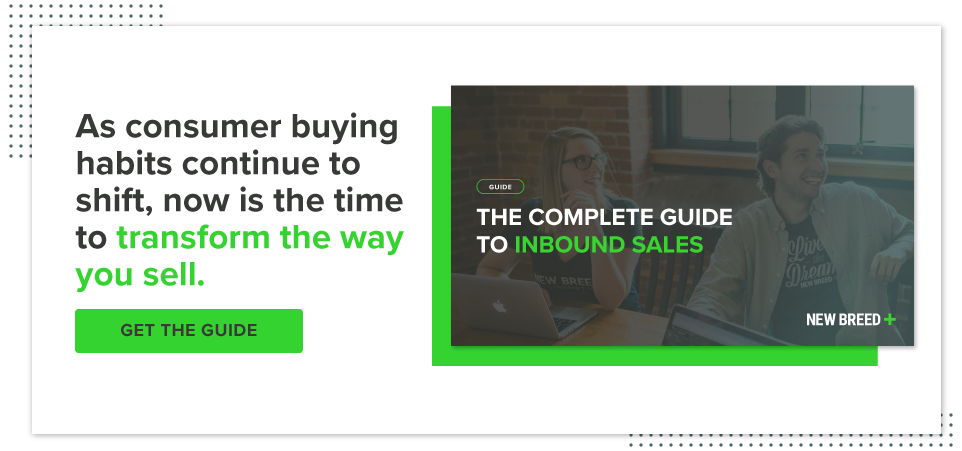How to Leverage “No” During the Sales Process

As you go through the sales process with a prospect, roadblocks are certain to come up. But a prospect saying no or raising an objection isn’t always a bad thing. Objections raised early in the sales process give you an opportunity to better understand your prospect’s situation so that you can make sure you’re offering them the best solution and that they understand the value your company can provide.
The biggest thing to decipher when those objections come up is whether it’s a big no or a small no. Small noes are objections like uncertainty about getting budget buy-in from their leadership team or a proposed project timeline not matching their expectations. A big no is when the sale is lost and the prospect is ending the sales process to pursue another solution.
I personally like to hear those small noes during the sales process because working through them can prevent a big no in the end. Throughout the sales process, I think it’s important to ask questions that prompt buy-in like:
- Does that make sense?
- How do you feel about [product]?
- Do you think this would be valuable to your team?
The goal is to get them to say yes, but sometimes they say no. When they do, it’s important to pause the sales process to work through that objection.
How to React When You Hear “No”
It can be frustrating to hear “no,” but it’s important not to let that sentiment come into your voice or hurt the conversation you’re having with a prospect.
Letting frustration take over can cause you to lose trust and rapport. If someone doesn’t trust your reaction to hard things, they can lose faith in your organization and your ability to service them causing you to lose the deal entirely. Losing that trust can also ruin your ability to discuss the issue at all.
Objections are normal parts of the sales process, so to prevent yourself from getting too frustrated, you should expect to hear no and need to talk through some of the challenges they’re facing and solve those problems live.
As you’re responding to a no, avoid acting defensive, giving overly short responses or acting in any other way that’ll come off uncomfortably. Instead, try to channel your feelings into a sentiment that can help you move the conversation in the right direction.
Showing confusion or surprise can open the door for the prospect to elaborate on the reasons why they said no. If it’s a more sensitive objection, like pricing, it can also be beneficial to soften your voice to be more gentle.
How to Turn an Objection Around
The most important step to turning an objection around is being prepared. Get familiar with the common objections that come up during your sales process so you’re not caught off guard live on a call and have some idea of how you can respond pre-determined.
But, while that preparedness can help keep the conversation from stalling, it’s just a starting point and shouldn’t lead to you making assumptions about a prospect. It’s important to understand where every individual is coming from so you can respond in an empathetic and very specific way.
You need to actively listen and truly try to understand why this prospect is saying no and what’s influencing them to respond that way. Even if they raise an objection you’ve heard many times before, when you dig deeper you might find that the underlying cause is different so your response will need to accommodate for that.
Also, keep in mind that you’re allowed to ask questions about an objection before responding to it. Asking “why?” will help you best address both expected and unexpected objections.
Once I get that information, I summarize what the prospect said back to me to make sure we have a mutual understanding. Once we’re on the same page, I’ll either offer up an alternative solution, rebut the objection or, if I don’t know what the solution would be, I’ll ask them what ideas for solutions they have.
Questions like “What would help you get past this?” and “What would help you move forward?” helps you understand not just the problem a prospect has but also what kind of solutions they’re looking for.
What to Do When a Deal is Closed-Lost
When it’s a big no, it’s really important that you do two things: first, thank the prospect for their time and their consideration and secondly learn as much as you can about why they made that decision.
Statistically in sales, more people will say no than will say yes. While you try your hardest to get each prospect to become a customer, realistically it’s not a decision everyone will make.
When you get that final rejection, react in a very positive way so if the opportunity arises for you to talk with them again in the future, they have a good impression to look back on. Think of the no as a no for now, not a no forever.
Additionally, ask about why they’re not closing with you. If it was a competitive deal and they went with a competitor over you, ask who they went with and why they chose them. That answer arms you with information that can help you prevent that outcome in the future.
On top of that, learn what you can do better personally. After every deal I win or lose, I look at why I won it or why I lost it, and I analyze how my sales process went, how I handled objections and what solutions I presented.
As long as prospects have had a good experience during the sales process, they’ll likely be willing to provide you with feedback. Just make sure you’re not asking for too much from them because if they’ve already moved on they might not have time to answer 10–15 questions. I recommend that you stick to two or three pieces of information that you need the prospect to tell you.
The Takeaway
The best way to overcome a no is to get to the objection as early in the process as possible so you can strategize to get around them. Hearing “no” for the first time as you’re working to finalize a sale will set you back a lot further than if you worked through multiple objections.
A prospect’s response to you working through an objection can also indicate how willing they are to actually find a solution with your company. If a prospect isn’t willing to have a conversation about why they said no to something, that’s a sign that they’re not likely to move forward with your company.
Keep in mind that the channel you’re communicating through can also impact how objections are given. People can be more prone to giving rejections through email rather than over the phone, even if most of your conversations have happened over the phone.
If you get a no through email, try to get that prospect on a call because it’s much more valuable to talk it over face-to-face.





